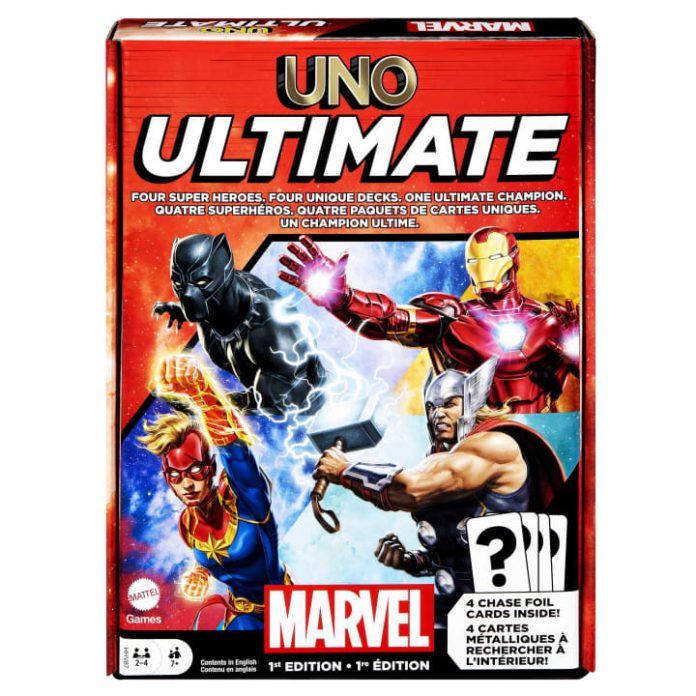UNO is a game I’ve played almost as long as I’ve been alive. In a lot of cases, it’s probably a universally enjoyed game of spite, malice, fierce combat, hard won victories and crushing defeats. It is also, well, UNO, meaning that while there is fun to be had, there isn’t always a lot of gas in the tank when it comes to new ideas or even just seasoned gaming groups.
I own quite a lot of variants of UNO, and they all run into a similar problem, which is that after a few plays, you’ve played about all you might play of UNO for a long time. So, color me surprised that one of my favorite recent gaming experiences was Mattel’s UNO Ultimate Marvel edition, which adds just enough flavor, variety, and spice to turn UNO into something a little more interesting, and the theming easily digestible to kids and adults alike.
Before we begin, one clarification: there are 2 starter sets for this, an ‘original’ and a ‘second edition’; the biggest changes are the characters in the starter box, but both are still widely available, and if you were only able to pick up one or the other, you wouldn’t find much difference between them.
What If… UNO Had Interaction?
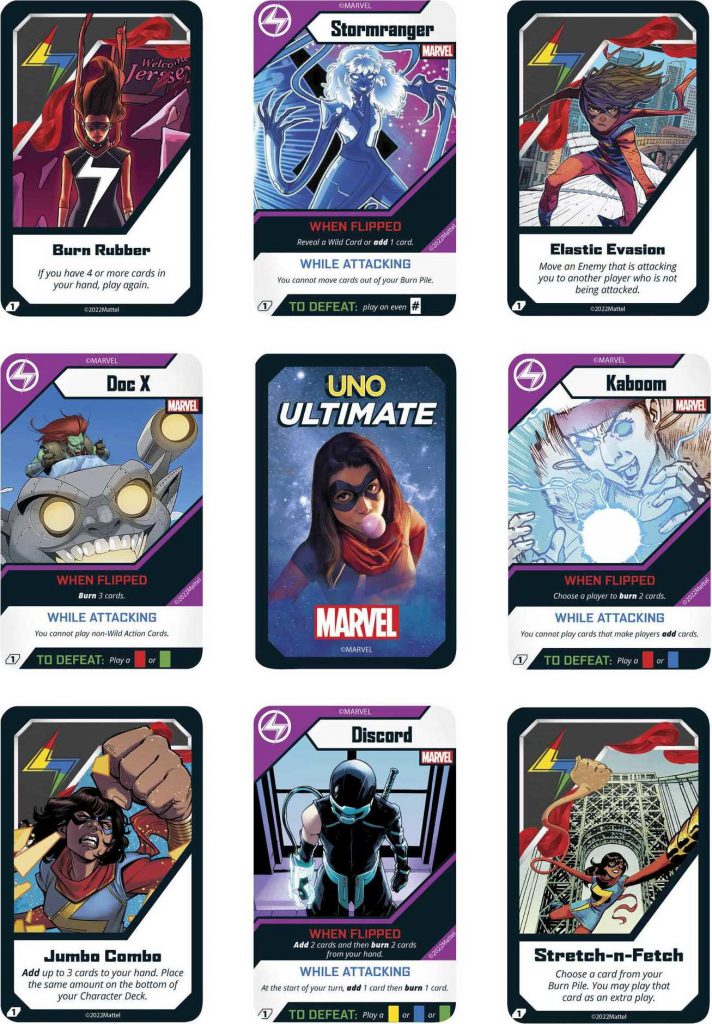
Probably the number one complaint about UNO is that the game lacks, as a function, much interaction between players. You either play a card or you draw a card, and the level of spite and malice at your table of UNO is mostly derived by mood and joviality, meaning that there really is no actual option on what to do, or what happens to you when you do play. Chiefly, each player receives a unique deck and character, one of numerous Marvel heroes, each with their own bespoke card art, character power, and unique wild cards that impact the game state in various ways.
A player’s turn is still generally what one might expect, but adds in a few variable things that can occur during a turn: Draw, Play, Add, Burn, or Recover. Draw and Play are self-explanatory, but Add requires a player to add cards to their hand but does not count as drawing; Burning puts cards from the player’s own deck of cards into a face up pile, and Recover allows players to put those burnt cards back on the bottom of their deck.
The most interesting new twist is the inclusion of Battles, in which characters may occasionally cause cards from the Danger deck to flip, revealing various villains who create twists and effects to the UNO game state. Some affect just the player who revealed them, others affect the entire table, but only the player who flipped the villain can try and defeat them on their following turn. These effects are never game destroying, but do add fun little wrinkles to each game played, especially if heroes are cycled in or change hands, and the deck shuffled. There is still not a lot of direct player interaction, but the way hero and villain powers change the game state do cause a little bit more chaos than simply causing Grandma to draw 24 cards and get you disinvited from Thanksgiving, so there’s that.
Avengers, Assemble 2-4 People, Preferably 4.
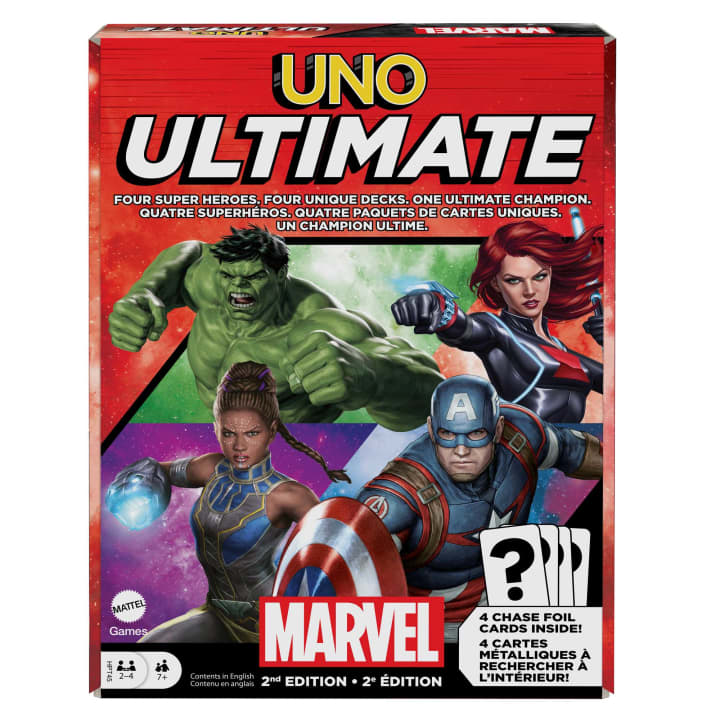
The rounds of UNO Ultimate I played surprised me in how fast, but how engaging, they ended up being. Random abilities creating changing table states was something I never thought I’d see in a game of UNO, but they did exactly that: a player that was about to win ended up adding cards to their hand by no fault of anyone’s direct action, but as a byproduct of the Danger Deck. In another, a player went from calling UNO to flipping a Danger card and immediately having to add cards back into their hand themselves.
The most fun part of Ultimate UNO, I came to realize, is the fact that the game itself causes the changes rather than planned, take-that style moves. While there are still the usual Skip, Reverse, and Draw cards mixed into each player’s deck, it is a lot harder to be actively malicious in stacking their effects or causing a situation in which one player is bullied into non-competition (at least, not without really, really trying to do so, as I’m sure one could likely achieve this if desired, but… why would you do that?).
The player powers are diverse, too, even in just the 4 decks that come in either starter box. They change the flow of the game without ever seeming intrusive, and have very mild impact on the game overall; Thor, for example, causes the next player in rotation to burn a card from their deck when he causes the color to change. At first, one of the players thought I was specifically targeting them, until the turn order shifted, which alleviated a bit of malice but only foretold the chaos to come.
Losing a card to burning it out of your deck is surprisingly impactful. Seeing a card that might have been the exact answer you needed (whether it be color, number, a power, or something else) get carelessly discarded feels almost worse than drawing more cards than you initially had. Even the ability to add a card to one’s hand feels strategic and useful, despite the usual thought of wanting less cards in UNO.
Many UNO variants, especially those with licenses attached, rarely feel… meaningful. The changes are cosmetic, adding in art or photographs and a random wildcard rule that doesn’t really change the actual speed of the game. UNO Ultimate makes an attempt at actively changing UNO’s flow, which works surprisingly well given the way the game works at a core level. I didn’t find UNO Ultimate to be longer, clunkier, or less fluid than UNO, and instead was surprised at how easy it was to pick up and play, even with the new rules being only quickly explained, thanks mostly to the fact that the core game doesn’t change at all.
Even better, set-up and tear down were simple, and the game is easy enough to play at various age levels; if a player is old enough to play and understand UNO, they’re old enough to understand UNO Ultimate, and for players who might roll their eyes at such a casual filler game, the new changes are enough to give it some legs, and at the very least, a far improved version of filler that feels more appropriate for seasoned groups of players. And that’s not even taking into account the ways the game can be expanded.
Crossover Event
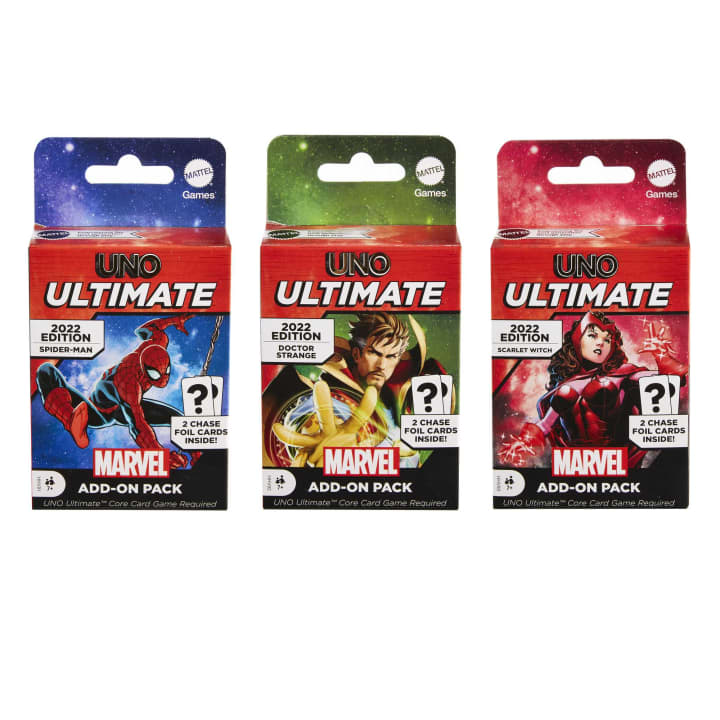
Out of the gate, the 2 starter sets provide 8 total heroes to play as (and a variety of villains and powers, more importantly), but one of the neater aspects of UNO Ultimate is the ability to expand the available options of characters to play as. None of these are required, but they are a fun way to add to the game and see what other playable options exist. When I had the chance to play with the Dr. Strange add-on, our table loved (although, at the time, loathed) the way his various Wild Cards restricted play actions in unique ways, and it again added to some of the tabletalk and discussion of the game afterwards. I can’t say that I’ve ever played UNO and had aftergame talk about what just happened before, so at the very least, UNO Ultimate scores some points for those.
These add-ons aren’t required, though, and that’s worth keeping in mind because the biggest downside to them is that they sometimes run the cost of the base game itself, or even more, and it can be a little difficult to discern which particular sets are widely available, which were limited, and if there are any more coming. If you can get them, they’re worth adding, but if you can’t, simply getting one or both of the base sets would likely set you up for a good amount of unique fun for under 30 dollars, which is a pretty solid deal in board games these days.
EXCELSIOR, True (UNO) Believers!
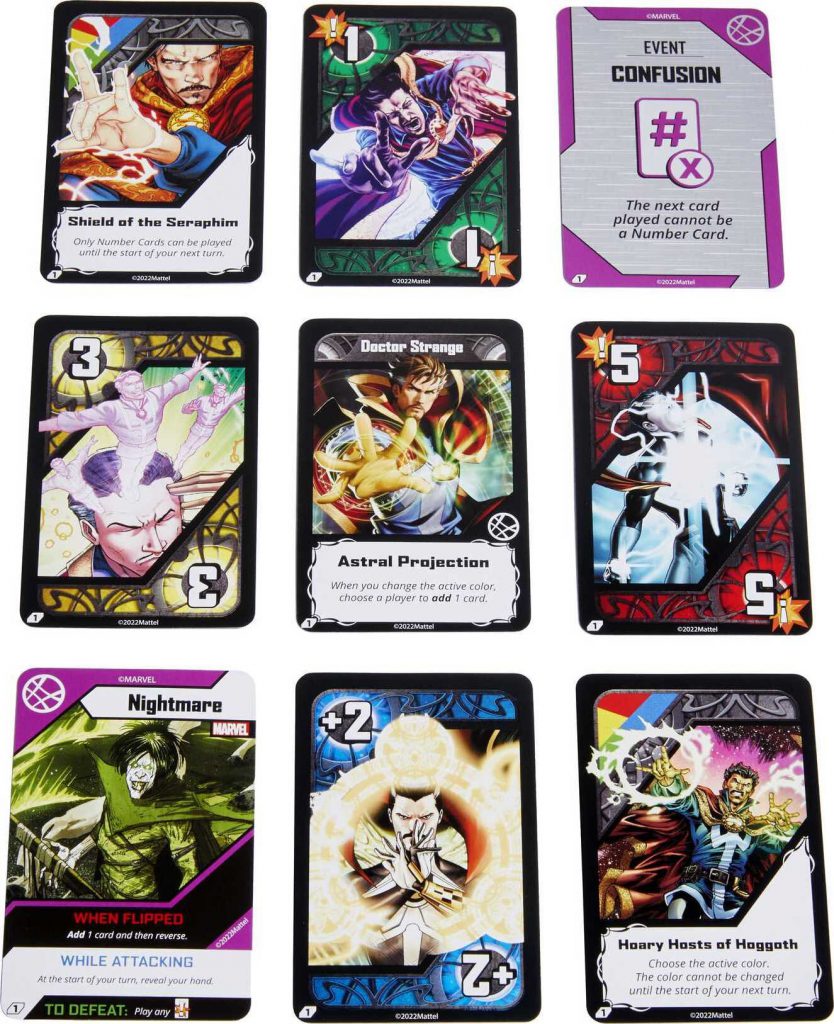
Frankly, I never thought I’d write a review for UNO, let alone an UNO variant [Ed. Never thought I’d read one either], but UNO Ultimate Marvel was the actual highlight of a recent gaming night. I was shocked by how fun and simple the game was, taking a familiar game and adding just enough spice to make it interesting and unique. The size of the box is about the only downside to making it perfect for take and play anywhere like a deck of UNO cards might normally be, but I’d play UNO Ultimate over UNO any day. Even at 2 players, it was just the extra layer of complexity caused by the Danger deck that made it so much more fun, and at 4, it was a great way to pass time while casually playing and relaxing.
The Marvel theme goes a long way, but even if Marvel isn’t something you enjoy, the way UNO Ultimate plays makes it worth adding to a collection as a great entry level game, a game night filler, or just a fun way to spice the game that came with everyone’s Xbox. It would be great to see more versions of UNO Ultimate or add-ons created for it, but even without additional content, there’s quite enough here to keep your table entertained and talking for a while to come.
